Views: 151 Author: Site Editor Publish Time: 2022-10-27 Origin: Site









Whether to use brads or finish nails depends on your woodworking task and the amount of holding power you need. Let's look at the differences between the two kinds of nails.
It’s All About the Gauge Size
The diameter of any nail is referred to as its gauge, and those sizes are numbered in ascending order from largest to smallest. For example, a 10-gauge nail is actually bigger than an 18-gauge nail. Most brad nails are made from a very thin 18-gauge wire. Finishing nails typically range from 16 to 15-gauges and are much more robust than brad nails. Finishing nails also come in a wider variety of lengths than most brad nails do; some can be upwards of 3” in length.
Brad Nails Vs. Finish Nails
A brad nail has a wider head than a finish nail.
When it comes to choosing brad nails vs. finish nails, it depends on your project and the type of wood you’re using. In general, go with finish nails for thick wood and brads for thin wood. Finish nails are stronger than brads, so choose them if your project needs to be durable.
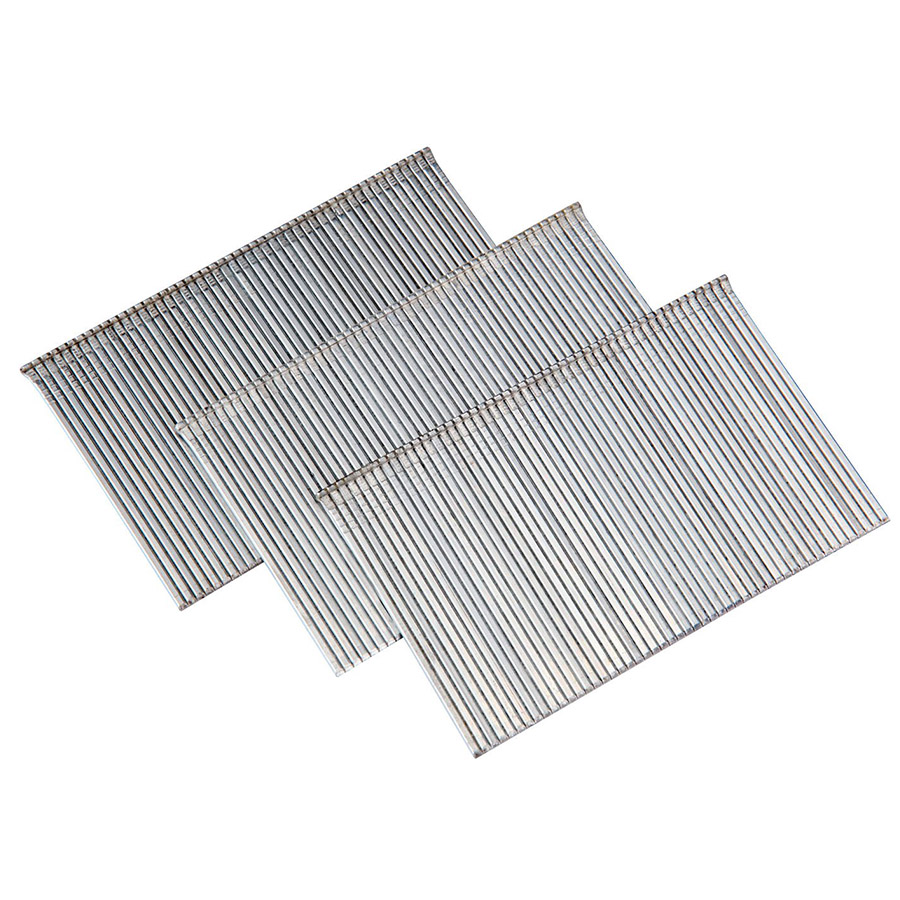
Brad Nails
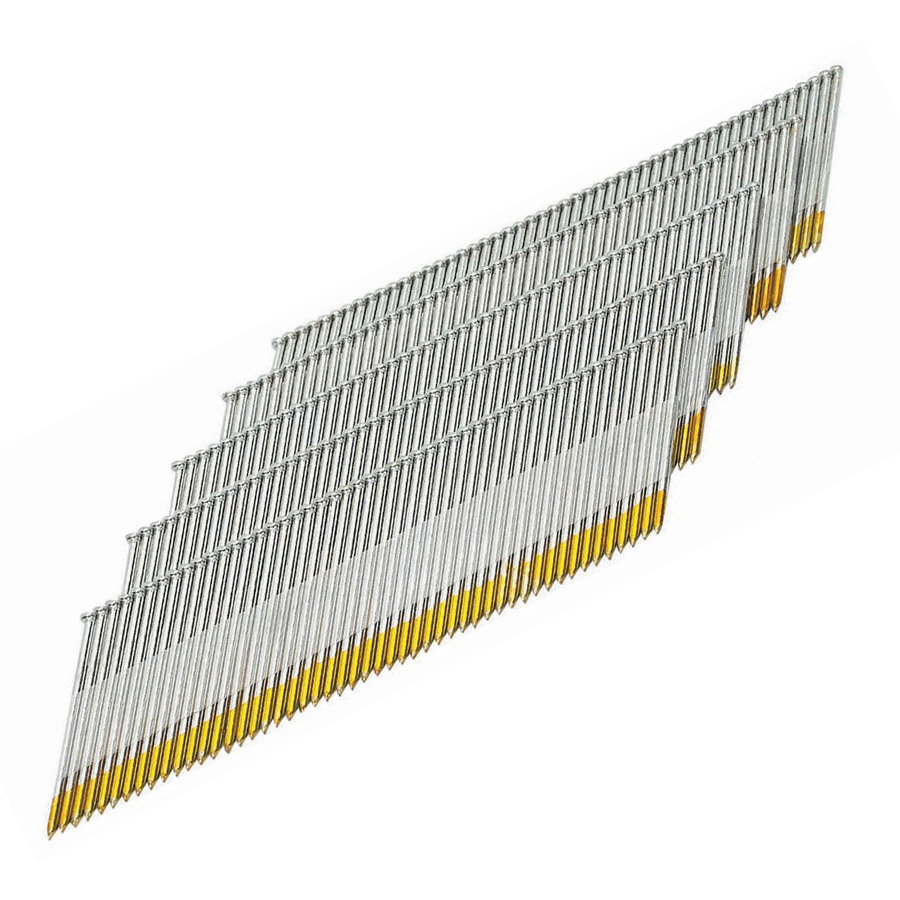
Finish Nails
A person using a nailer with brad nails to fasten a wooden shelf together.
Brad nails, or brads, are essentially an 18-gauge wire that’s been formed into a sharpened nail. They’re generally much thinner than your average finishing nail. Thinner nails have higher gauge numbers. The small diameter of brad nails makes them easy to mask in wood trim or paneling. In addition to being thinner than standard nails, they also feature a smaller head.but it's possible to find headless variations for applications where hole filling is not acceptable or possible.
The slender profile of brad nails helps to prevent splitting on delicate material. Their subtle appearance often makes for a clean finish in various woodworking projects.
Because brad nails themselves are thin, they work best in thinner cuts of lumber, including fiberboard and plywood. The small diameter of brads means that your moulding and trim work will show less of a hole and might not need wood filler before painting.

16 Gauge Brad Nails Size:
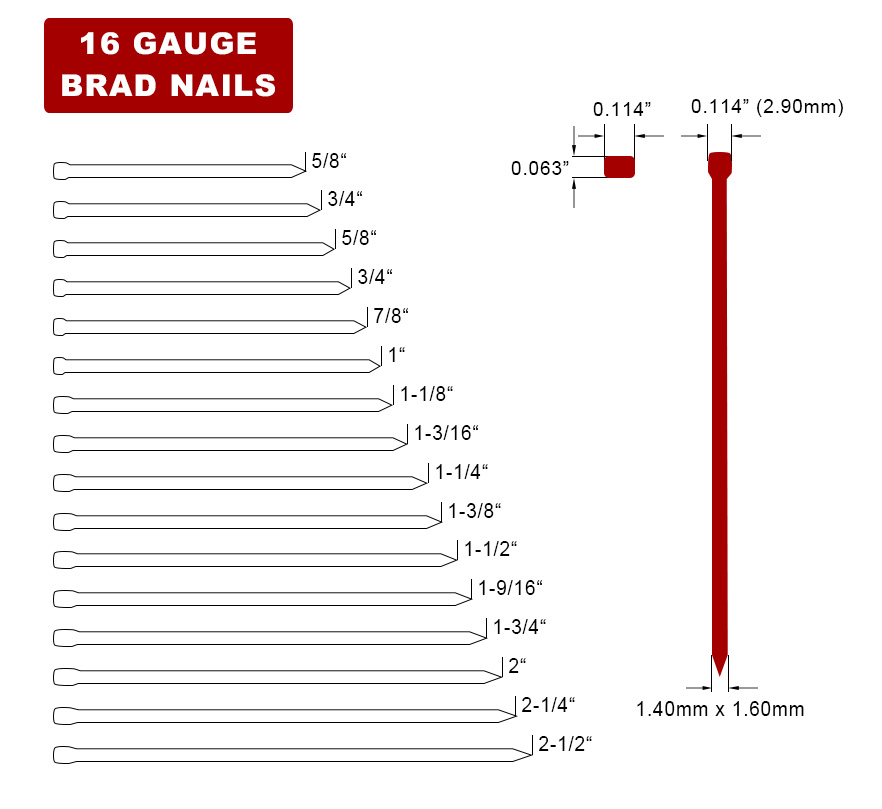
| Item | Our Specification | Length | Pcs/Stick | Package | |||||
| mm | inch | Pcs/Box | Bxs/Ctn | Ctns/Pallet | Weight Ctn (G.W.) | Weight Pallet (G.W.) | |||
| T15 | T Brads Nails | 15mm | 5/8" | 50Pcs | 2500Pcs | 20Bxs | 50 | 11.5Kgs | 575Kgs |
| T16 | GAUGE: 16GA | 16mm | 5/8" | 50Pcs | 2500Pcs | 20Bxs | 50 | 12.1Kgs | 605Kgs |
| T19 | HEAD WIDTH: 2.90mm | 19mm | 3/4" | 50Pcs | 2500Pcs | 20Bxs | 50 | 14.9Kgs | 745Kgs |
| T22 | WIDTH: 1.60mm | 22mm | 7/8" | 50Pcs | 2500Pcs | 20Bxs | 50 | 17.24Kgs | 862Kgs |
| T25 | THICKNESS: 1.40mm | 25mm | 1" | 50Pcs | 2500Pcs | 20Bxs | 50 | 19.7Kgs | 985Kgs |
| T28 | 28mm | 1-1/8" | 50Pcs | 2500Pcs | 20Bxs | 50 | 21.5Kgs | 1075Kgs | |
| T30 | 30mm | 1-3/16" | 50Pcs | 2500Pcs | 20Bxs | 50 | 22.7Kgs | 1135Kgs | |
| T32 | 32mm | 1-1/4" | 50Pcs | 2500Pcs | 20Bxs | 50 | 24.5Kgs | 1225Kgs | |
| T35 | 35mm | 1-3/8" | 50Pcs | 2500Pcs | 10Bxs | 50 | 13.6Kgs | 680Kgs | |
| T38 | 38mm | 1-1/2" | 50Pcs | 2500Pcs | 10Bxs | 50 | 14.6Kgs | 730Kgs | |
| T40 | 40mm | 1-9/16" | 50Pcs | 2500Pcs | 10Bxs | 50 | 15.3Kgs | 765Kgs | |
| T45 | 45mm | 1-3/4" | 50Pcs | 2500Pcs | 10Bxs | 50 | 16.8Kgs | 840Kgs | |
| T50 | 50mm | 2" | 50Pcs | 2500Pcs | 10Bxs | 50 | 18.9Kgs | 945Kgs | |
| T57 | 57mm | 2-1/4" | 50pcs | 2500Pcs | 10Bxs | 50 | 21.3Kgs | 1065Kgs | |
| T64 | 64mm | 2-1/2" | 50Pcs | 2500Pcs | 10Bxs | 50 | 23.8Kgs | 1190Kgs | |
18 Gauge Brad Nails Size:
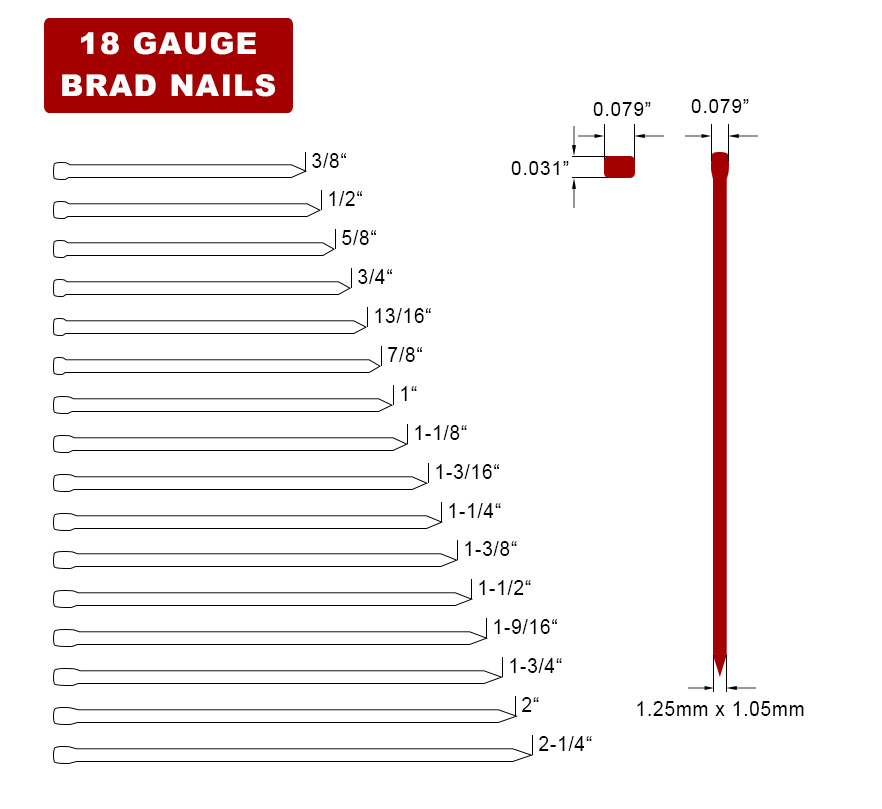
| Item | Our Specification. | Length | Pcs/Stick | Package | |||||
| mm | inch | Pcs/Box | Bxs/Ctn | Ctns/Pallet | Weight Ctn (G.W.) | Weight Pallet (G.W.) | |||
| F/10 | F Brads Nails | 10mm | 3/8" | 100Pcs | 5000Pcs | 30Bxs | 60 | 13.9Kgs | 834Kgs |
| F/13 | GAUGE: 18GA | 13mm | 1/2" | 100Pcs | 5000Pcs | 30Bxs | 60 | 18.4Kgs | 1104Kgs |
| F/15 | HEAD WIDTH: 2.00mm | 15mm | 5/8" | 100Pcs | 5000Pcs | 30Bxs | 50 | 21.1Kgs | 1055Kgs |
| F/16 | WIDTH: 1.25mm | 16mm | 5/8" | 100Pcs | 5000Pcs | 30Bxs | 50 | 22.6Kgs | 1130Kgs |
| F/19 | THICKNESS: 1.00mm | 19mm | 3/4" | 100Pcs | 5000Pcs | 20Bxs | 50 | 17.7Kgs | 885Kgs |
| F/20 | 20mm | 13/16" | 100Pcs | 5000Pcs | 20Bxs | 50 | 18.3Kgs | 915Kgs | |
| F/22 | 22mm | 7/8" | 100Pcs | 5000Pcs | 20Bxs | 50 | 19.7Kgs | 985Kgs | |
| F/25 | 25mm | 1" | 100Pcs | 5000Pcs | 20Bxs | 50 | 21.9Kgs | 1095Kgs | |
| F/28 | 28mm | 1-1/8" | 100Pcs | 5000Pcs | 20Bxs | 50 | 25.1Kgs | 1255Kgs | |
| F/30 | 30mm | 1-3/16" | 100Pcs | 5000Pcs | 10Bxs | 60 | 13.7Kgs | 822Kgs | |
| F/32 | 32mm | 1-1/4" | 100Pcs | 5000Pcs | 10Bxs | 60 | 14.2Kgs | 852Kgs | |
| F/35 | 35mm | 1-3/8" | 100Pcs | 5000Pcs | 10Bxs | 60 | 15.7Kgs | 942Kgs | |
| F/38 | 38mm | 1-1/2" | 100Pcs | 5000Pcs | 10Bxs | 60 | 17Kgs | 1020Kgs | |
| F/40 | 40mm | 1-9/16" | 100Pcs | 5000Pcs | 10Bxs | 60 | 17.7Kgs | 1062Kgs | |
| F/44 | 44mm | 1-3/4" | 100Pcs | 5000Pcs | 10Bxs | 50 | 19.3Kgs | 965Kgs | |
| F/45 | 45mm | 1-3/4" | 100Pcs | 5000Pcs | 10Bxs | 50 | 19.8Kgs | 990Kgs | |
| F/50 | 50mm | 2" | 100Pcs | 5000Pcs | 10Bxs | 50 | 21.7Kgs | 1085Kgs | |
| F/57 | 57mm | 2-1/4" | 100Pcs | 5000Pcs | 10Bxs | 50 | 26.7Kgs | 1335Kgs | |
Brad nails are formed from a fine, 18-gauge wire, so they are smaller in diameter than finish nails and typically have less holding strength. They're better suited for tasks like light decorative trim and molding, panel installation and crafts. Their size also helps prevent surface splitting, which can occur if the fastener is too large for the material it's being driven into.
One of the benefits to an 18 gauge brad is its size. Thanks to a smaller head and diameter, brad nails are easier to conceal in small pieces of wood trim. With a smaller head size, it's possible that the insertion point may not even need to be concealed with wood putty. In other words, 18-gauge brad nails provide a cleaner look than a finish nail without extra touch-up involved.
Brad nails are thin, 18 gauge nails made for more delicate woodworking jobs.
They’re available in collated strips for nail guns or individual pieces.
Brad nail length ranges from 1/2-inch to 2 1/2-inch.
Their slim profile reduces wood splitting.
They leave small holes that often don’t need to be filled.
Common brad nails uses include decorative trim, picture frame and paneling. They work well on birdhouses and other thin cuts of wood. Brad nails are excellent for trim work, including narrow trim around windows or doors, shoe moulding and quarter-round moulding.
Due to the thinner gauge of a brad nail, they're often used for lightweight, indoor applications. Anytime you're working with delicate materials that risk splitting while nails are being driven, it's a good time to use brad nails. The thin gauge of a brad nail also makes it easier to hide and provides a damage-free finish when driven properly. Brads are commonly used to attach shoe moldings and small ornamental parts on furniture.
Brad nails are also useful when gluing delicate wooden parts together. It's often helpful to apply glue to a joint and then drive a few brad nails into your project to hold everything while the glue dries.
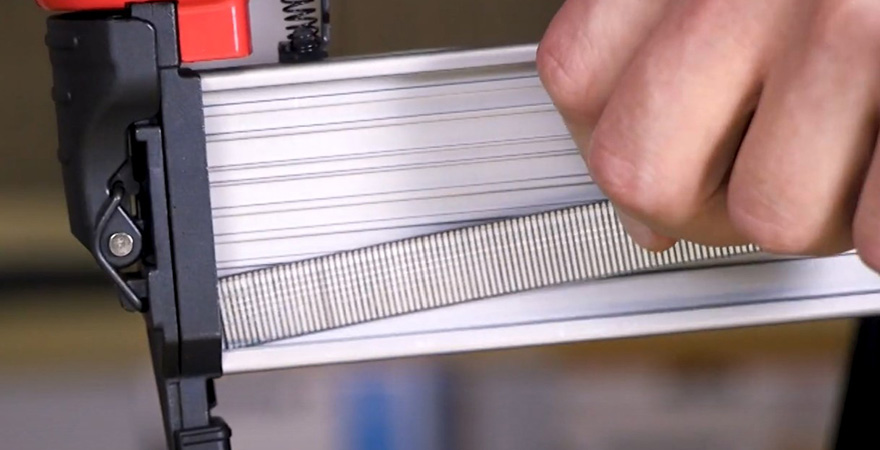
One of the benefits of brad nails is their small size, but that advantage also makes them super hard to drive by hand. It's extremely difficult to hold a brad nail with your fingers and still have enough room to hit it with a hammer. You can solve this problem with a thin strip of cardboard. Just poke the nail through the cardboard and use that to position your nail. Now you can freely hit your nail with your hands out of the way.
If you've got a larger number of brads to drive, or if you find yourself using them frequently, an electric or pneumatic nail gun might be a good fit for you. Powered brad nailers can hold hundreds of brads and will drive them gently into your project with tremendous ease. Nail guns come with some advantages when working with very small brads or pin nails. The ability to drive a nail with one hand is not only efficient but can be extremely helpful when you're working alone and trying to hold parts together. Most brad nailers can drive a diverse range of brads, from the tiniest 1/4" headless brads to bigger 1-1/2" round head brads.
Brad nails are a great choice and are one of the easiest, most affordable fasteners to use when you need a clean look and finish. Throw a small box into your tool kit and find out how handy they are around the house. Everything from hanging small photos to installing shoe molding can be tackled with just a handful of brad nails.
Brad nails are great for craft projects or any task that simply requires a minimal amount of holding strength. Brads are easily removed and leave very small holes, so they’re great for temporary applications as well. Brads also have the advantage of being very easy to conceal, and their light gauge does a good job of preventing wood from splitting. Brads are notoriously difficult to drive by hand. The small size makes them difficult to hold, and they’re prone to bending. This is problematic in tight spaces that prevent you from making a clean hit on the nail. It’s often more advantageous to drive brads with an electric or pneumatic nail gun.
A person using a nailer to fasten baseboards to a wall.
Finish nails, or finishing nails, are generally made of 15- or 16-gauge steel wire, making them slightly thicker in diameter than brad nails. The added thickness means that finishing nails create a stronger hold than brads. This makes them useful for heftier applications with thicker material, such as cabinets or baseboards.
The greater diameter of finish nails leaves a wider hole after fastening a piece of wood. For this reason, you’ll need to follow up with a filler to conceal the spots and tidy your handiwork.
Because they are thicker than brad nails, finish nails are more likely to split thin or delicate pieces of wood trim.
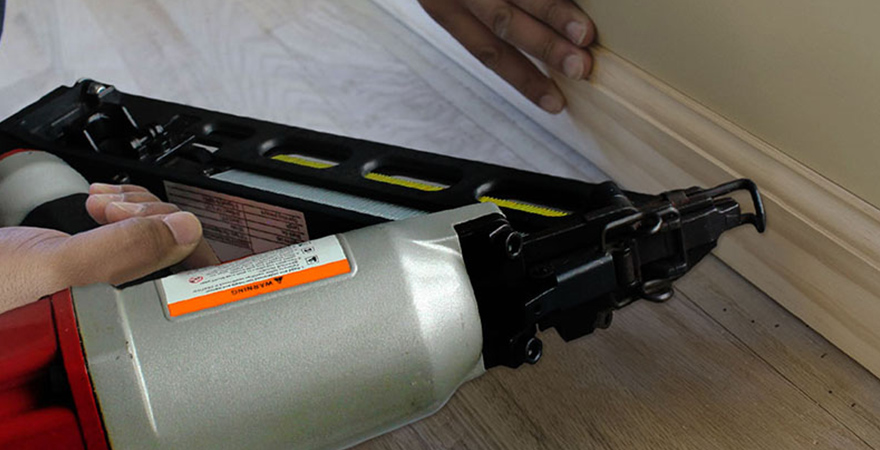
15 gauge finish nails size
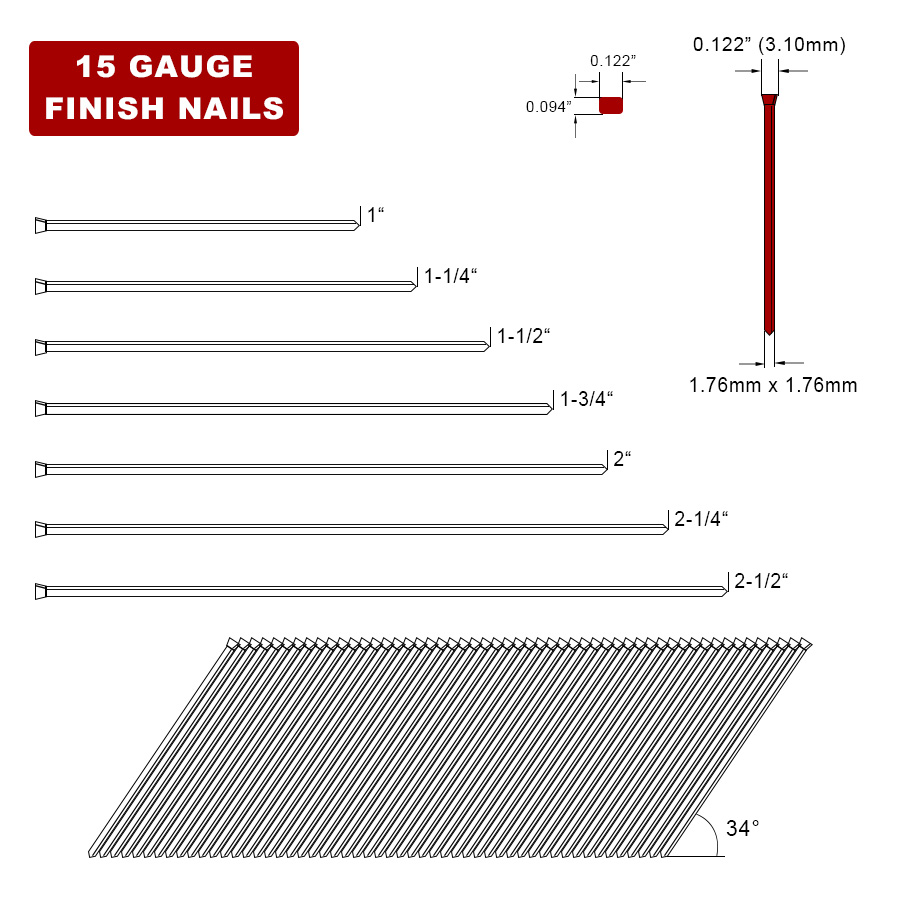
| Item | Our Specification | Length | Pcs/Stick | Package | |||||
| mm | inch | Pcs/Box | Bxs/Ctn | Ctns/Pallet | Weight Ctn (G.W.) | Weight Pallet (G.W.) | |||
| DA/25 | ANGLE DA FINISH NAILS | 25mm | 1" | 100Pcs | 4000Pcs | 4Bxs | 120 | 8.58Kgs | 1029.6Kgs |
| DA/32 | DEGREE:34° | 32mm | 1-1/4" | 100Pcs | 4000Pcs | 4Bxs | 120 | 10.9Kgs | 1308Kgs |
| DA/38 | GAUGE: 15GA | 38mm | 1-1/2" | 100Pcs | 4000Pcs | 4Bxs | 90 | 12.74Kgs | 1146.6Kgs |
| DA/45 | HEAD WIDTH: 3.10mm x 2.4mm | 45mm | 1-3/4" | 100Pcs | 4000Pcs | 4Bxs | 80 | 14.9Kgs | 1192Kgs |
| DA/50 | WIDTH: 1.76mm | 50mm | 2" | 100Pcs | 4000Pcs | 4Bxs | 60 | 16.74Kgs | 1004.4Kgs |
| DA/57 | THICKNESS:1.76mm | 57mm | 2-1/4" | 100Pcs | 4000Pcs | 4Bxs | 60 | 18.62Kgs | 1117.2Kgs |
| DA/64 | LENGTH:25mm-64mm | 64mm | 2-1/2" | 100Pcs | 4000Pcs | 4Bxs | 60 | 20.74Kgs | 1244.4Kgs |
Finish nails are made from heavier 15- or 16-gauge wire, which means they can handle a greater payload. For larger trim, such as baseboards or crown molding, a finish nail is more suitable. A finish nail offers increased support and withdrawal resistance versus the brad nail, making it the better choice when installing larger trim and woodwork.
Because it leaves a more visible hole in the surface, a fully driven finish nail almost always requires followup attention—which includes being puttied over to conceal the "shiner" (the exposed insertion point of a nail). In all,
Finish nails are versatile nails with a 15- or 16-gauge diameter.
They’re designed for thicker cuts of wood.
They’re available in collated finishing nail strips for nail guns or individual pieces.
Finish nail length ranges from 1-inch to 3 1/2-inch.
Their heavier gauge brings greater holding strength to projects.
Finish nails are used for interior and exterior trim, window and door casing and chair rails. They’re ideal to fasten baseboards and crown moulding too. You’ll also find finish nails on stair treads and risers, as well as part of general light carpentry and cabinets.
Finish nails are far more robust than brad nails, and they’re ideal for applications that require more strength and holding power. A finish nail is far more suitable for things like crown molding, paneling and cabinetry. Finish nails are much harder to remove than a brad nail, so they’re especially good for things like doorway trim that gets a lot of abuse. Finish nails also have the advantage of length. It’s possible to hang paneling over drywall and hit the studs with a finish nail of an appropriate length. Finish nails do require some extra attention because they almost always leave a small visible dimple in the surface. A nail punch is usually needed to drive the nail head just below the surface to allow for concealment. While this extra step adds some difficulty, the finish nail remains the preferred choice for larger trim and woodworking projects.
Generally speaking, no. Most carpenters on any job site have dedicated nail guns for brads and for finish nails. Since their applications require slight differences in the shape of the nail gun, it’s not really possible to combine the two. Because of the difference in sizes and lengths, both nail guns need to operate at different strengths to allow for the nails to be driven neatly and safely. Both electric and pneumatic nail guns are available for each type of nail, and they’re widely available in local home stores.
If you're looking for the right nails and tools to get the most out of your home improvement projects, Get a free quote right now.